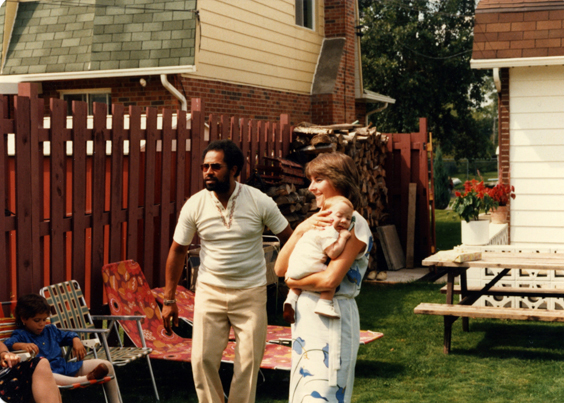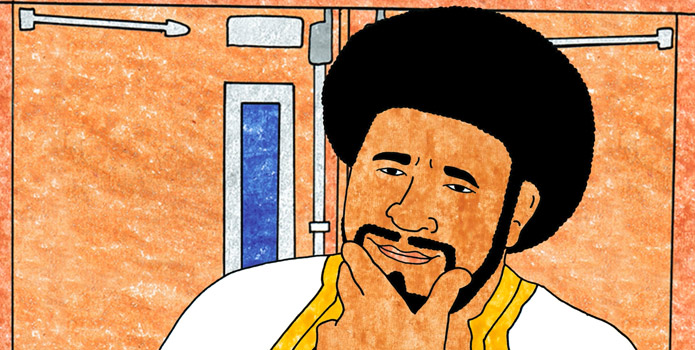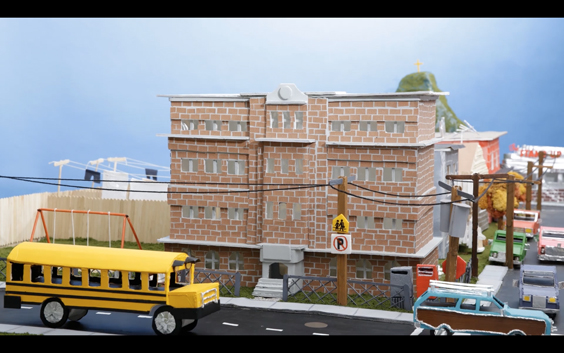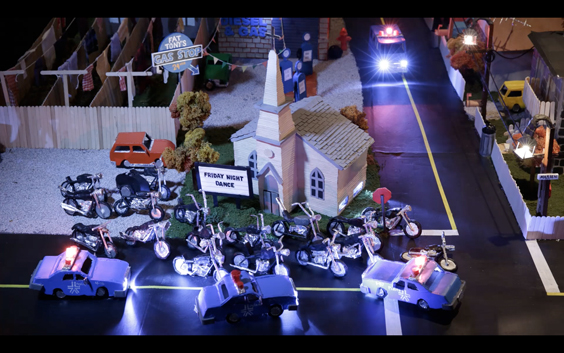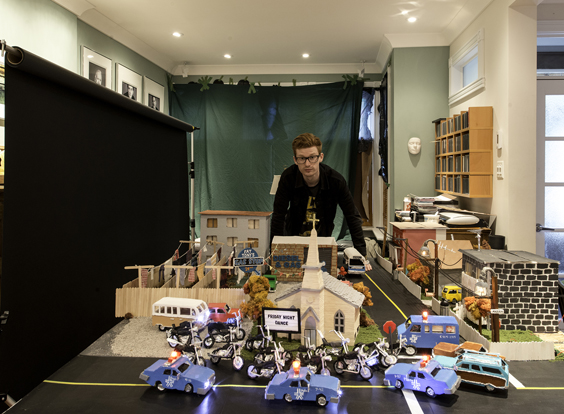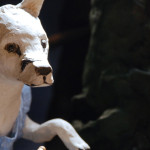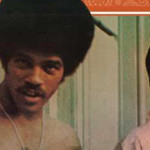“THE CHAPERONE 3D”: An Interview with Director Fraser Munden
Featuring charming, hand-drawn lines that transport you back to intimate, shared classroom doodles, The Chaperone is a 3D documentary that’s more like a kid’s craft show. Combining rotoscoped figures, motion, cardboard cutout paper, puppetry, and live action, The Chaperone tells the story of real-life Montreal school teacher Ralph Whims, who must defend students from the unwanted attentions of a biker gang looking to crash the school dance.
Living at the heart of The Chaperone’s incredible visuals is Montreal’s rich culture. The film’s unpretentious nods to the city surpass the usual clichés, instead incorporating French-Canadian swear words, St-Leonard neighbourhood accents and legendary seedy strip-clubs up there with topless breakfast joint “Les Princesses Serveuses Sexy”.
Spectacular Optical’s Esinam Beckley caught The Chaperone 3D at a hometown screening on the heels of its world premiere at TIFF, and talked Fraser Munden – who directed the film with Neil Rathbone – about combining multiple filmmaking techniques in the same film, the underlying insecurity of Canadian filmmakers, and how he is influenced by Blaxploitation film art.
***
Esinam Beckley: How did you meet Ralph Whims and hear his incredible story?
Fraser Munden: Ralph was my father’s elementary school teacher. Stefan, who was the DJ at the dance, is my dad’s best friend. My dad is a great storyteller who especially likes to highlight the exploits of his friends, so I heard the story of the night Ralph and Stefan took on the bikers many times. Every summer growing up my family would stay at Stefan’s country place and Ralph lived not too far away on the same lake and that’s when I’d see a lot of Ralph. I remember being in awe of Ralph’s huge hands. It was totally conceivable to me that he could have done a lot of damage with them.
EB: We are given a tireless array of creative techniques in this film – 3D, hand-drawn animation, stop-motion and puppets. How did you get the idea to use these styles for documentary filmmaking?
FM: The last two animated documentaries the team and I worked on were both driven mainly by hand-drawn animation, so naturally that was the base we had to work with. But the movement of the drawings was achieved through motion graphics and not frame-by-frame animation. Beyond that, all the other styles emerged in the storyboarding phase. We tried to tailor the animation approach to whatever felt right for what was being conveyed in the story and then we tried to keep it consistent throughout the movie. For example, stop motion is only used for the exterior establishing shots. Another example would be any time a character has to manipulate an object with their hand (like turn off a light, open a door or pick up a phone) we would shoot it in live-action with an animatronic hand covered in plasticine that Neil made.
Choosing to do it in 3D was a whole adventure unto itself. 3D was something new and exciting and we thought it would be a good learning experience. To be honest I can’t say that I thought 3D would make The Chaperone a more convincing documentary, but I did think it would make the experience a whole lot more unique. And Chris McMahon, our stereographer, totally took on the task of learning 3D. We did go out of our way to make sure the details that appear in The Chaperone were accurate, or at least accurate to the era the story takes place in. Using rotoscoping allowed us to actually use the real Ralph’s facial expressions; I’d just make him look younger when I drew him.
One thing we did do intentionally in The Chaperone was choose to have the “Kneebreakers” segment live action. Every style we chose had purpose, and for “Kneebreakers” the intended goal was to trick the audience into thinking that there actually was a kung-fu movie about two guys who go around breaking people’s knees. If we had animated “Kneebreakers” in the style of the rest of The Chaperone, it wouldn’t have gotten the right response we were going for.
EB: Do people have difficulty accepting The Chaperone as documentary because of the animation techniques you use?
FM: The funny thing is, if we were to hire tons of actors and rent costumes and stage a massive live action recreation of the events of that night I think people would be much more comfortable with the label of documentary for The Chaperone. Look at a movie like Errol Morris’ The Thin Blue Line, a film made up almost entirely of staged events. I think people are much more comfortable calling that a documentary because it’s live action.
EB: It seems that Montreal has an important presence in your animated shorts. All the stories are set in and around Montreal, but done without a pretentious over-awareness.
FM: One thing I really don’t like in movies set in Montreal is how there’s always this lame thing about “Oh this character is French but this character is English, look how zany things are in this city!” I think there’s a real insecurity, especially from English Montreal filmmakers, to just tell the story they want to tell without having to go through the process of explaining the city to whoever’s watching. I think that’s what limits so many movies made in Canada, rendering them “Canadian movies” and not just movies that are part of the regular movie universe. A city shouldn’t have to re-introduce itself in every movie, you shouldn’t have to justify why you set a movie in Montreal in the same way a filmmaker wouldn’t feel insecure setting a movie in New York or London or Mystery, Alaska. There’s a couple times Ralph and Stefan slip into French in The Chaperone and it happens seamlessly. We’ve shown it to American audiences and they laugh just the same at those parts with no confusion.
EB: You have a documentary called Shotgun! Fidel & the Queen about Canadian boxer Ian Clyde, who is from Verdun. Can you talk a bit about how you chose to do a short about him, and how it came to be?
FM: My father is a huge boxing fan and spotted Ian at an event called “The Point St-Charles Hall of Recognition”. I get really excited whenever I meet a character my father had previously mythologized, especially if they’re from Point St-Charles or Verdun. My family really connected with him and he’s the type of guy that’s impossible not to get along with. Ian is just boiling over with incredible anecdotes. He was trained by the most famous boxing trainer of all-time, Angelo Dundee, and is seemingly connected to every boxing personality (and often world leader) of the 20th century. I was taking a video class in university and had to find a documentary subject so I approached him. Shotgun! was filmed in only one night at Ian’s place, so you get a sense of the kind of material that’s there. I’d love to do something more in-depth with Ian one day in the future.
EB: What are a few of your personal influences?
FM: As far as The Chaperone is concerned, we heavily referenced the poster artwork of the Blaxploitation era. The Blaxploitation poster art period was the best art period since the Renaissance.
My personal favorite films are Hoop Dreams and Goodfellas. I love movies and I aspire to make ones like the two I just mentioned, but I think probably my true influences will be the countless YouTube videos I’ve watched over the years, and I think that’s true for anybody living in the Internet age. You’re saturated with so much stuff online it’s got to have an impact on the language and the way media is put together.
EB: At the Montreal screening, you mentioned you had no animating experience. Can you describe the actual mechanics or process of how you went from doodling to animated doodles?
FM: When we set off the make The Chaperone we were really committed to the idea of stepping up our game, but didn’t totally know what that meant. I initially was reticent to use rotoscoping for anything other than for the talking heads of modern Ralph and Stefan. I thought that rotoscoping was acceptable in those cases because those were supposed to be the most real parts of the short. I remember I was really into the idea of making original marionettes of every character, filming them in action, and then rotoscoping over that to give the impression we were coming up with our totally original style of animation. I guess a lot of that had to do with a level of insecurity because we weren’t classically trained animators and were worried that anything other than pure animation was cheating. But then gradually we realized that using rotoscoping really wasn’t cheating and was tremendously labor intensive. Everything that’s rotoscoped in the movie is done by hand, pen on paper. My parents’ basement is filled with the frames from the movie.
In the beginning, before our first short Why Was I Out There, Neil [Rathbone] and I would complete each others’ drawings in class. We would draw a single image, then someone would give life to those still images in After Effects using motion graphics. Doing frame by frame animation and combining it with motion graphics layering it all in stereoscopic 3D was just an evolution of that.
EB: Do you think you’ll continue on with new film ideas in the same style or structure as your shorts? What would you like to do after this?
FM: The beauty of doing animated documentaries with unscripted narration as the base is that you’ll never run out of stories or cool ways to animate them. But in the near future I’d like to try my hand at doing some live action stuff just so I can get outside of my parents basement.
I would love to write a full feature live action film and just pour the same level of detail that’s in The Chaperone into every frame. The idea of working with a crew of people on a big set who are all obsessed with those kinds of details is what gets me excited. At one point in The Chaperone a biker loses his tooth as he’s being punched by Ralph. The detail of the flying tooth is imperceptible to the human eye and can only be seen if you pause the movie, but for me knowing that it’s there is what’s important.
****
The Chaperone 3D Slamdance Trailer from Thoroughbread Pictures on Vimeo.

 February 25, 2014
February 25, 2014  1 Comment
1 Comment

